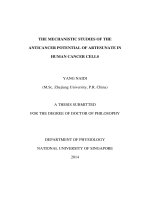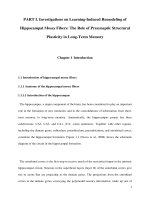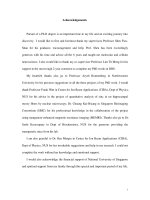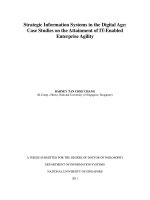Studies on the intracellular signalling pathways triggered by the anaphylatoxin c5a in human phagocytic cells 1
Bạn đang xem bản rút gọn của tài liệu. Xem và tải ngay bản đầy đủ của tài liệu tại đây (1.02 MB, 79 trang )
STUDIES ON THE INTRACELLULAR SIGNALING
PATHWAYS TRIGGERED BY THE ANAPHYLATOXIN
C5a IN HUMAN PHAGOCYTIC CELLS
FARAZEELA BINTE MOHD IBRAHIM
(B.Sc. (Hons.), NUS
A THESIS SUBMITTED
FOR THE DEGREE OF DOCTOR OF PHILOSOPHY
DEPARTMENT OF PHYSIOLOGY
NATIONAL UNIVERSITY OF SINGAPORE
2006
ACKNOWLEDGEMENTS
I am extremely grateful and indebted to my supervisor, Dr Alirio J Melendez, for his
advice and guidance throughout the course of my research in the lab. Regardless of
his commitments and busy schedule, he always found time to supervise my work and
was never short of comforting and motivating words for me, especially when the
going was tough. Without his support and encouragement, this work would not have
been accomplished. It was an eye-opening and wonderful experience to conduct
research under his supervision. Thank you very much for introducing me to this
fascinating world of research.
Special thanks belong to my lab colleagues who have given me excellent cooperation
and assistance throughout my stay in the Molecular and Cellular Immunology Lab in
the Department of Physiology. I am honored to have had the opportunity to work with
each and every one of them in different aspects of my research. In them, I have found
firm friends and I truly cherish the friendship we share.
I wish to acknowledge my deepest gratitude and appreciation to my husband, who has
been my constant source of encouragement and moral support, my pillar of strength
and my confidante, without whom this journey would have been that much harder.
I am thankful to my parents, sisters and family members for their support and love
throughout my life. The knowledge of them being there has been of great
encouragement and importance to me.
I would also like to thank Ms Anneke Melendez-Fraser for her helpful comments,
invaluable advice and the time spent proofreading this thesis.
i
TABLE OF CONTENTS
Acknowledgements i
Table of Contents ii
Summary vii
List of Figures ix
Abbreviations xii
List of Publications xiv
List of Posters and Abstracts presented xv
CHAPTER I INTRODUCTION
1.1 The complement system 1
1.1.1 Complement proteins and nomenclature 2
1.1.2 Activation of the complement cascade 3
1.1.2.1 The classical pathway 3
1.1.2.2 The alternative pathway 4
1.1.2.3 The mannan-binding lectin (MBL) pathway 5
1.1.3 Functions of the complement system 7
1.1.4 Regulation of the complement system 9
1.1.5 Complement component C5a 10
1.1.5.1 Biological properties of C5a 10
1.1.5.2 Structure of ligand C5a 11
1.1.5.3 Complement 5a receptor (C5aR) 13
1.1.5.4 Role of C5a in diseases 16
1.2 Important downstream events triggered by C5a 17
1.2.1 NADPH oxidase 17
ii
1.2.2 Nuclear factor kappa B 18
1.2.3 Matrix metalloproteinases 20
1.2.4 Raf-Mitogen activated protein kinases 22
1.2.5 Cytokines 24
1.3 Sphingosine Kinase (SPHK) 26
1.3.1 Sphingolipid metabolism 26
1.3.2 Properties of SPHK 28
1.3.3 Activation and regulation of SPHK 29
1.3.4 Sphingosine-1-phosphate (S1P) 30
1.3.5 Role of SPHK and S1P in cellular processes 30
1.3.6 Role of SPHK and S1P in immune cells 32
1.4 Phospholipase D (PLD) 35
1.4.1 Transphosphatidylation reaction 35
1.4.2 Diversity and structure of PLD enzymes 37
1.4.3 Properties of mammalian PLD 38
1.4.4 Regulation of PLD enzymes 40
1.4.5 Downstream signaling of PLD products 41
1.4.6 PLD activity in immune cells 43
1.5 Rationale of the project 44
CHAPTER II MATERIALS AND METHODS
2.1 Chemicals 45
2.2 Solutions and Buffers 47
2.3 Cell culture and differentiation of cells 50
iii
2.4 Transfection of cells with oligonucleotides 50
2.5 RNA extraction and reverse transcription-PCR 51
2.6 Isolation of primary human neutrophils 51
2.7 Isolation of primary human monocytes and differentiation to 52
macrophages
2.8 C5a receptor stimulation 52
2.9 Measurement of sphingosine kinase activity in cell extracts 53
2.10 Measurement of sphingosine-1-phosphate generation in whole cells 53
2.11 Phospholipase D activity assay 54
2.12 Phospholipase C activity assay 55
2.13 Protein kinase C activity assay 55
2.14 Cytosolic calcium measurement 56
2.15 Chemotaxis assay 56
2.16 NADPH oxidative burst assay 57
2.17 Degranulation assay 57
2.18 Subcellular fractionation by differential centrifugation 58
2.19 Gel electrophoresis and western blotting analysis 58
2.20 Measurement of NF-κB activation 59
2.21 Measurement of cytokine release 61
2.22 Measurement of matrix metalloproteinase release 62
2.23 Fluorescence microscopy 63
2.24 Flow cytometry for cell viability 63
CHAPTER III RESULTS
3.1 Key role for sphingosine kinase in C5a signaling in human neutrophils 64
3.1.1 C5a stimulates SPHK activity in human neutrophils 67
iv
3.1.2 Role of SPHK in C5a-triggered Ca
2+
signals 70
3.1.3 Role of SPHK in C5a-triggered degranulation 73
3.1.4 Role of SPHK in C5a-triggered chemotaxis 73
3.1.5 Role of SPHK in C5a-triggered NADPH oxidative burst 74
3.1.6 SPHK is the enzyme activated by C5a. Antisense knockdown 78
of SPHK1
3.1.7 SPHK1 mediates C5a-triggered Ca
2+
release, degranulation, 80
chemotaxis and NADPH oxidase activity
3.1.8 Effects of DMS and/or antisense oligonucleotides 83
3.1.9 Effects of sphingosine and sphingosine-1-phosphate on signaling 87
3.1.10 Discussion 91
3.2. Key role for sphingosine kinase in C5a signaling in human macrophages 96
3.2.1 C5a stimulates SPHK activity in human macrophages 98
3.2.2 SPHK1 is the enzyme activated by C5a. Antisense knockdown 100
of SPHK1
3.2.3 Role of SPHK1 in C5a-triggered Ca
2+
signals 103
3.2.4 Role of SPHK1 in C5a-triggered PKC activity 105
3.2.5 Role of SPHK1 in C5a-triggered degranulation 105
3.2.6 Role of SPHK1 in C5a-triggered chemotaxis 108
3.2.7 Role of SPHK1 in C5a-triggered cytokine production 108
3.2.8 Discussion 112
3.3 Potential role for phospholipase D in C5a signaling in macrophages 116
3.3.1 C5a stimulates PLD activity in dbcAMP-differentiated U937 cells 119
3.3.2 C5a stimulates the translocation and redistribution of PLD1 119
isoform
3.3.3 Role of PLD in C5a-triggered Ca
2+
signals 122
v
3.3.4 Role of PLD in C5a-triggered NADPH oxidase activity 122
3.3.5 Role of PLD in C5a-triggered degranulation 125
3.3.6 Role of PLD in C5a-triggered chemotaxis 125
3.3.7 Role of PLD in C5a-triggered NF-κB translocation and activation 128
3.3.8 Role of PLD in C5a-triggered cytokine production 131
3.3.9 Role of PLD in C5a-triggered matrix metalloproteinase (MMP) 131
release
3.3.10 C5a induces Raf-1 translocation and phosphorylation of ERK1/2 135
and p38
3.3.11 C5a-triggered PLD activity is potentially upstream of SPHK, 138
ERK1/2, p38 MAPK and PKC
3.3.12 Discussion 140
CHAPTER IV CONCLUSION 149
CHAPTER V REFERENCES 152
vi
SUMMARY
Anaphylatoxins play a key role in inflammatory responses, and in many diseases they
contribute to the pathogenesis. Inflammation is the body’s natural response to tissue
damage and injury, and is mediated by several interconnected enzymatic pathways.
One such pathway is the complement cascade, through which the anaphylatoxin C5a,
a potent stimulator of mediators of chronic and acute inflammation, is generated.
Although the actions of C5a are well established, the mechanisms regulating C5a-
triggered intracellular signaling pathways are poorly understood. The phospholipid-
modifying enzymes, sphingosine kinase (SPHK) and phospholipase D (PLD), are
emerging as important signaling molecules, and have been suggested to function as
crucial players in the physiological responses triggered by activated immune-effector
cells.
Hence, the objective of my study is to investigate the intracellular signaling pathways
triggered by C5a, particularly the roles of SPHK and PLD, in mediating
proinflammatory functions in human neutrophils and macrophages. The ultimate goal
is to identify key molecules as candidates for novel therapeutic intervention.
In this thesis, I provide evidence that demonstrate, for the first time, that the
anaphylatoxin C5a activates the intracellular signaling molecule SPHK, and present
data that support the role for SPHK in the proinflammatory responses triggered by
C5a in human neutrophils and macrophages, showing that inhibition of this enzyme
has potential anti-inflammatory properties. We demonstrate that C5a receptor
activation stimulates SPHK activity in these cells. Moreover, the inhibition of SPHK
by DMS inhibits C5a-stimulated Ca
2+
mobilization, degranulation, chemotaxis, and
NADPH activation in these cells. Furthermore, an antisense oligonucleotide specific
for SPHK1 also inhibited the C5a-induced responses, suggesting that SPHK1 is the
vii
isoform triggered by C5a. We also show here that C5a stimulation decreases cellular
sphingosine levels and increases the formation of sphingosine-1-phosphate (S1P),
suggesting a role for SPHK in removing a negative regulator (sphingosine), and
generating a positive regulator (S1P). We also studied the effects of exogenously
added sphingosine and S1P in the neutrophils. We found that sphingosine has no
effect on C5a-triggered Ca
2+
signals, chemotaxis and degranulation, but dual effect on
C5a-stimulated NADPH oxidase activation and minimal effect on C5a-triggered PKC
activity. S1P by itself did not induce degranulation or chemotaxis, but it did
marginally induce Ca
2+
signals and the oxidative burst. However, S1P showed a
priming effect, enhancing all C5a-triggered responses.
I also present data that suggest the potential role of PLD in C5a-induced
proinflammatory responses in macrophage-differentiated U937 cells. In the presence
of a primary alcohol (butan-1-ol), C5a-triggered Ca
2+
signals, NADPH oxidative
burst, chemotaxis, degranulation, NF-κB translocation and activation, cytokine
release and MMP release are significantly inhibited, suggesting a role for PLD in
triggering these responses. I also show that C5a induces Raf-1 translocation, which
may activate MAPKs, and that PLD activity is potentially upstream of some signaling
enzymes.
Thus, our data contribute not only to the understanding of the intracellular molecular
mechanisms utilized by C5a, suggesting that SPHK and PLD potentially play key
roles in C5a-triggered proinflammatory functions, but also point out SPHK and PLD
as novel candidates for potential therapeutic intervention to treat inflammatory and
autoimmune diseases.
viii
LIST OF FIGURES
Introduction:
Figure A Complement activation pathways 6
Figure B Ribbon diagram of the human C5a molecule 12
Figure C Model for the interaction of C5a with C5aR 15
Figure D Sphingolipid metabolic pathway 27
Figure E PLD-catalyzed hydrolysis and transphosphatidylation reactions 36
Figure F PLD metabolic pathway 42
Figure G C5a-triggered intracellular signaling in human phagocytic cells 148
Results:
Figure 1 C5a triggers SPHK activity in primary human neutrophils and 68
differentiated HL-60 cells (neutrophil model)
Figure 2 C5a triggers S1P generation in primary human neutrophils and 69
differentiated HL-60 cells (neutrophil model)
Figure 3 C5a-triggered cytosolic Ca
2+
signals in neutrophils are inhibited 71
by DMS: role for SPHK
Figure 4 C5a-triggered phospholipase C activity in neutrophils is not 72
inhibited by DMS
Figure 5 Degranulation triggered by C5a in neutrophils is dependent on 75
SPHK activity
Figure 6 C5a-induced chemotaxis in neutrophils is inhibited by the SPHK 76
inhibitor
Figure 7 C5a-induced NADPH oxidase activity in neutrophils is inhibited 77
by DMS
ix
Figure 8 SPHK1 expression, subcellular localization and antisense 79
knockdown
Figure 9 SPHK1 mediates the physiological responses triggered by C5a 81
in differentiated HL-60 cells
Figure 10 Role of DMS and/or SPHK1 antisense oligonucleotide on cell 84
viability, PKC activity, calcium signals, S1P generation and
sphingosine levels in neutrophils
Figure 11 Role of exogenously added sphingosine or S1P on neutrophil 88
functions
Figure 12 C5a triggers S1P generation and SPHK activity in human 99
macrophages
Figure 13 SPHK1 expression, subcellular localization and antisense 101
knockdown in the human monocyte-derived macrophages
Figure 14 S1P generation and SPHK activity in SPHK1 antisense 102
knockdown in human monocyte-derived macrophages
Figure 15 C5a-triggered cytosolic Ca
2+
signals in macrophages are inhibited 104
by DMS, showing a role for SPHK
Figure 16 C5a-triggered PKC activity in the monocyte-derived macrophages 106
is not inhibited by the SPHK1 antisense
Figure 17 Degranulation triggered by C5a in macrophages is dependent on 107
SPHK activity
Figure 18 C5a-induced chemotaxis is inhibited in macrophages pretreated 109
with the SPHK1 antisense
Figure 19 TNF-α, IL-6, and IL-8 release triggered by C5a is inhibited in 110
macrophages pretreated with the SPHK1 antisense
Figure 20 C5a triggers PLD activity in differentiated U937 cells 120
x
Figure 21 Only PLD1 translocates upon C5a trigger in macrophages 121
Figure 22 C5a-triggered cytosolic Ca
2+
signals are inhibited by butan-1-ol: 123
a role for PLD
Figure 23 NADPH oxidative burst is potentially PLD-dependent 124
Figure 24 C5a-induced degranulation is dependent on PLD activity 126
Figure 25 PLD potentially mediates C5a-induced chemotaxis 127
Figure 26 C5a-induced NF-κB translocation and activation is inhibited by 129
butan-1-ol
Figure 27 IL-6 and IL-8 release triggered by C5a in differentiated U937 132
cells is mediated by PLD
Figure 28 PLD plays a potential role in C5a-induced MMP release 133
Figure 29 C5a induces the translocation of Raf-1 in the macrophage-like 136
cell model
Figure 30 C5a receptor stimulation activates ERK1/2 and p38 MAPK 137
Figure 31 C5a-induced PLD activity in differentiated U937 cells is 139
independent of the activation of SPHK, ERK1/2, p38 MAPK
and PKC
xi
ABBREVIATIONS
AM Acetoxymethyl ester
AP-1 Activating protein-1
APMA p-Aminophenylmercuric acetate
APS Ammonium persulfate
Arf Adenosine diphosphate-ribosylation factor
a.s. Antisense
ATP Adenosine triphosphate
BAPTA Bis(o-aminophenoxy)-ethane-N,N,N’,N’-tetraacetic acid
BisI Bisindolymaleimide I
bp Base pair
BSA Bovine serum albumin
C5a Complement factor 5a
C5aR C5a receptor (CD88)
CGD Chronic granulomatous disease
CR Complement receptor
DAG Diacylglycerol
DAGK Diacylglycerol kinase
dbcAMP Dibutyryl cyclic adenosine monophosphate
DHS DL-threo-dihydrosphingosine
DMS N,N-dimethylsphingosine
DNA Deoxyribonucleic acid
DTT Dithiothreitol
ECM Extracellular matrix
EDG Endothelial differentiation gene
EDTA Ethylenediaminetetraacetic acid
EGTA Ethyleneglycol-bis(β-aminoethyl)-N,N,N′,N′-tetraacetic Acid
ELISA Enzyme-linked immunosorbent assay
ER Endoplasmic reticulum
ERK Extracellular signal-regulated kinase
FCS Fetal bovine serum
FITC Fluorescein isothiocyanate
fMLP Formyl-methionyl-leucyl-phenylalanine
GPCR G-protein coupled receptor
GTP Guanine triphosphate
HIV Human immunodeficiency virus
hr Hours
HRP Horse radish peroxidase
Ig Immunoglobulin
IκB Inhibitor of κB
IKK IκB kinase
IL-6 Interleukin 6
IL-8 Interleukin 8
IP
3
Inositol-1,4,5-trisphosphate
JAK Janus kinase
LPA Lysophosphatidic acid
MAC Membrane attack complex
MAPK Mitogen activated protein kinase
xii
MAPKK Mitogen activated protein kinase kinase
MAPKKK Mitogen activated protein kinase kinase kinase
MASP MBL-associated serine proteases
MBL Mannan-binding lectin
min Minutes
MMP Matrix metalloproteinases
mRNA Messenger ribonucleic acid
NADPH Nicotinamide adenine dinucleotide phosphate
NF-κB Nuclear factor kappa B
NLS Nuclear localization sequence
NPB Nuclear preparation buffer
OD Optical density
PA Phosphatidic acid
PAF Platelet-activating factor
PAPH Phosphatidic acid phosphohydrolase
PBS Phosphate buffered saline
PC Phosphatidylcholine
PI Propidium iodide
PIP
2
Phosphatidylinositol-4,5-bisphosphate
PIP
3
Phosphatidylinositol-3,4,5-triphosphate
PKC Protein kinase C
PLA
2
Phospholipase A
2
PLC Phospholipase C
PLD Phospholipase D
PMN Polymorphonuclear cells
PMSF Phenylmethylsulphonyl fluoride
PtdBut Phosphatidylbutanol
PtdEtOH Phosphatidylethanol
RHD Rel-homology domain
RIPA Radioimmunoprecipitation
RLU Relative luminescence unit
ROS Reactive oxygen species
RPMI Roswell Park Memorial Institute
RT-PCR Reverse transcription-polymerase chain reaction
S1P Sphingosine-1-phosphate
SDS Sodium dodecyl sulfate
SDS-PAGE SDS-polyacrylamide gel electrophoresis
SPHK Sphingosine kinase
STAT Signal transducers and activators of transcription
TAD Transcriptional activation domain
TBS Tris-buffered saline
TBST TBS with Tween-20
TEMED N,N,N',N'-Tetramethylethylenediamine
TIMP Tissue inhibitors of metalloproteinase
TLC Thin layer chromatography
TMB 1,3,5-trimethylbenzene
TNF-α Tumor necrosis factor alpha
TRITC Tetramethylrhodamine isothiocyanate
VCAM Vascular cell adhesion molecule
WHO World Health Organisation
xiii
LIST OF PUBLICATIONS
Ibrahim FB, Pang SJ, Melendez AJ (2004) Anaphylatoxin signaling in human
neutrophils. A key role for sphingosine kinase. J Biol Chem 279(43):44802-11
Melendez AJ, Ibrahim FB (2004) Antisense knockdown of sphingosine kinase 1
in human macrophages inhibits C5a receptor-dependent signal transduction,
Ca
2+
signals, enzyme release, cytokine production, and chemotaxis. J Immunol
173(3): 1596-603
xiv
LIST OF POSTERS AND ABSTRACTS PRESENTED
Ibrahim FB, Melendez AJ. Phospholipase D mediates anaphylatoxin triggered
effector functions in macrophages.
Abstract accepted for poster presentation at the Combined Science Meeting held at
Raffles Convention Centre, Singapore in November 2005.
Abstract published in supplement issue of Annals, Academy of Medicine, Singapore.
Ibrahim FB, Melendez AJ. Intracellular signaling via anaphylatoxin C5a receptor
in macrophages: a key role for phospholipase D.
Abstract accepted for poster presentation at the 2005 FASEB Summer Research
Conference ‘Immunoreceptors’ held in Tucson, Arizona, USA in July 2005.
Ibrahim FB, Melendez AJ. SPHK1 mediates anaphylatoxin triggered physiological
responses in phagocytic cells.
Abstract presented for poster presentation in the Best Basic Science Poster Award at
the 8
th
NUH-NUS Annual Scientific Meeting held in NUS, Singapore in October
2004.
Ibrahim FB, Pang SJ, Leung BP, Melendez AJ. Sphingosine Kinase 1 mediates
intracellular Ca
2+
release, degranulation, cytokine production and chemotaxis in
response to anaphylatoxins.
Abstract accepted for poster presentation at the 12
th
International Congress of
Immunology (ICI) and the 4
th
Annual Meeting of Federation of Clinical Immunology
Society (FOCIS) held in Montreal, Canada in July 2004.
Abstract published in the supplement of Clinical Investigative Medicine.
Tan Ryan, Ibrahim FB, Melendez AJ. Study on the intracellular signaling
pathways triggered by C5a in macrophages.
Abstract presented at the 16
th
Science Research Congress held in NUS, Singapore in
Mar 2004.
Ibrahim FB, Melendez AJ. Study on the intracellular signaling pathways triggered
by C5a in macrophages.
Abstract presented at the Postgraduate conference on Immunology and Cancer
Biology held at the City University of Hong Kong, Hong Kong in February 2003.
Ibrahim FB, Melendez AJ. Studies on the intracellular signaling pathways
triggered by anaphylatoxin C5a on phagocytic cells: new targets for
inflammatory and autoimmune diseases.
Abstract accepted for poster presentation in the 6
th
NUH-NUS Annual Scientific
Meeting held in NUS, Singapore in August 2002.
SCHOLARSHIP
National University of Singapore Research Scholarship Jul 2002 – Jul 2006
xv
CHAPTER I
INTRODUCTION
1.1 The complement system
Traditionally, the complement system has been viewed as a major defense and
clearance system in the bloodstream that forms a central component of the innate
immune system. However, in recent years, complement activation has been
implicated in the pathogenesis of many inflammatory and immunological diseases,
including sepsis (Ward, 2004), asthma (Hawlisch et al., 2004), rheumatoid arthritis
(Linton and Morgan, 1999), multiple sclerosis (Ffrench-Constant, 1994),
glomerulonephritis (Welch, 2002), adult respiratory distress syndrome (Robbins et al.,
1987) and ischemia-reperfusion injury (Arumugam et al., 2004).
The complement system was identified, based on the concept of bloodstream
clearance of micro-organisms. It was Pfeiffer who first described complement as
being principally a heat-labile bactericidal activity in serum (Pfeiffer and Issaeff,
1894). Later in 1898, Bordet proved that complement was a substance, rather than
merely an activity found in the serum, which ‘complemented’ the effects of specific
antibodies in the lysis of bacteria and red blood cells (Bordet and Gengou, 1901).
Ehrlich then coined the term ‘complement’ to denote those factors in normal serum,
that were able to demonstrate the lysis of cells or micro-organisms, when functioning
together with antigen-bound antibodies (Ehrlich, 1996).
Over the years, it has been established that there is marked conservation of the
complement system between invertebrates and mammals, suggesting that they share a
common ancestry in host defense and tissue homeostasis (Dodds and Law, 1998;
Sahu and Lambris, 2001). However, while the complement system in invertebrates is
1
very simple and composed only of two or three proteins, that of mammals is highly
complex, and includes over 30 proteins. Many of these proteins interact with each
other to form different functional complexes, eventually leading to the formation of a
membrane attack macromolecule with microbicidal properties (Smith et al., 2001).
1.1.1 Complement proteins and nomenclature
The mammalian complement system is composed of at least 35 proteins, which are
normally found as soluble components in plasma. These include proteolytic pro-
enzymes, as well as non-enzymatic components that form functional complexes, co-
factors, regulators and receptors. From the initial point of activation to the terminal
stage of cell lysis, complement proteins get sequentially activated in a cascade
fashion, thus providing tremendous amplification and activation of large amounts of
complement by relatively small initial signals (Lutz and Jelezarova, 2006).
The nomenclature of the complement system is often a significant obstacle to
understanding this system. There are two distinct ways of characterizing the
complement proteins (IUIS-WHO, 1981; WHO, 1968). The plasma proteins that were
originally described are defined as ‘components’ and each is designated with a prefix
‘C’, followed by a number 1 to 9. Thus C1 to C9 (refer to Figure A), together with the
membrane attack complex (MAC), make up the classical pathway. As for the
alternative pathway, the two proteins involved in the initiation and also the regulatory
proteins are termed ‘factors’ and given capital letters (Factor B and Factor D, Factor
H and Factor I, respectively). Fragments from the proteolytic cleavage of a certain
component are represented by lower case letters, such as C5a and C5b (coming from
C5), while the complement receptors are denoted by the symbol of the protein or
fragment to which they bind, followed by the capital letter R (C5aR).
2
1.1.2 Activation of the complement cascade
Three pathways of complement activation have been recognized: the classical,
alternative and mannan-binding lectin pathway (Figure A). They differ according to
the nature of recognition. Early complement activation is characterized by a sequence
of proteolytic reactions, in which complement zymogens undergo successive cleavage
to generate two fragments. The larger cleavage product is often the active serine
protease that remains covalently bound to the pathogen surface, to ensure the
activation of the next component zymogen. The smaller liberated fragment is released
from the activation site and functions as a soluble mediator. The early events
converge at the central component of the complement system C3, and from there, the
pathways take a final common pathway, which leads to the formation of a protein
complex on a complement-activating surface, the MAC.
1.1.2.1 The classical pathway
The first complement pathway that was discovered, the classical pathway, is initiated
by the binding of C1q to the Fc regions of IgG or IgM within immune complexes, or
other structures such as HIV (Cooper et al., 1976), bacterial structures (Alberti et al.,
1993), double-stranded DNA (Jiang et al., 1992) or pentraxins such as C-reactive
protein (Jiang et al., 1991). This interaction promotes a conformational change in the
C1q molecule, consequently activating the serine proteases C1r and C1s. Activated
C1s cleaves C4 into C4a and C4b, of which the latter binds covalently to the
complement-activating surface. C4b binds C2, which is subsequently cleaved by C1s,
to form C2a and C2b. While C2b is released, C2a remains bound to C4b and they
form the C4b2a complex. Also known as the C3 convertase, this complex then
cleaves C3, generating C3a and C3b, which attaches itself to the C4b2a complex to
3
form C4b2a3b heterotrimeric complex, which has C5 convertase activity. Cleavage of
C5 produces C5a and C5b, which functions as the initiator of the terminal phase of the
complement activation. C5b binds to C6 followed by C7. This reaction leads to a
conformational change that exposes a hydrophobic site on C7, enabling the insertion
of the complex itself into the lipid bilayer of the cell membrane of the invading
pathogen. C8 also undergoes similar changes. Collectively, the complex C5678 forms
small pores in the membrane that may potentially lead to lysis. However, the perforin-
like C9 is the fundamental component that does the damage. C9 polymerizes around
the C5678 complex to form the MAC. This is essentially a transmembrane channel
that allows the free passage of water and solutes across the lipid bilayer, leading to a
loss of cellular homeostasis. The end result is lysis of the target cell (Guo and Ward,
2005; Seelen et al., 2005; Walport, 2001).
1.1.2.2 The alternative pathway
The alternative pathway was discovered as a second pathway for complement
activation after the classical pathway had been characterized (Gotze and Muller-
Eberhard, 1976). This pathway is activated by whole micro-organisms and their
products, such as lipopolysaccharides, zymosan and teichoic acid, and also certain cell
surfaces. More importantly, the alternative pathway can be initiated through the
spontaneous hydrolysis of circulating C3, forming C3b, that can become covalently
attached to microbial surfaces. The bound C3b then binds to a serum factor called
Factor B, forming a C3bB complex. The complex is then further activated by another
serum factor, Factor D, which cleaves Factor B while it is still attached to C3b. The
complex generated from this cleavage is C3bBb, which is the assembled C3
convertase of the alternative pathway. Similar to that produced in the classical
4
pathway, the C3 convertase functions to cleave more C3 molecules, thus amplifying
the initial signal. Due to the spontaneous nature of the hydrolysis of C3 to C3b, there
needs to be a regulatory thermostat that shuts down this amplification process.
Properdin is one such serum protein that binds to and stabilizes the C3bBb complex
on microbial cells, while regulating the rapid dissociation of the C3bB complex on
host cells. Other regulators include Factor H and Factor I, which inactivate the
released C3b. With the formation of the C3 convertase, the alternative pathway takes
on the same route as the classical pathway, ultimately leading to the MAC formation.
The two complement activation pathways do not function in isolation. In fact, they are
highly interconnected because the amplification steps in the alternative pathway also
play a similar role in the classical pathway. Thus the alternative pathway serves to
amplify both antibody-dependent and antibody-independent cleavage of C3 (refer to
Figure A) (Guo and Ward, 2005; Seelen et al., 2005; Thurman and Holers, 2006).
1.1.2.3 The mannan-binding lectin (MBL) pathway
The lectin pathway is mediated by plasma mannose-binding lectins that serve as
recognition molecules (Turner, 2003). MBL exists as a complex, with the MBL
associated serine proteases, MASP-1, -2 and -3, and will bind to mannose residues,
found in many proteins and polysaccharides, that are found uniquely in micro-
organisms but not in mammals. Analogous to the C1q of the classical pathway, the
MBL proteins initiate the MBL pathway in a similar manner as the classical pathway.
Activated MBL proteins trigger the MASPs, which are equivalent to the C1r and C1s
of the classical pathway, for the cleaving of C4 and C2, leading to the formation of C3
and C5 convertase of the classical pathway. The pathway then takes a similar route as
the other two pathways (Fujita et al., 2004; Petersen et al., 2001).
5
C1
Activated C1
C4a
C4 + C2
C4b2a
C4b2a3b
Antigen-Antibody
(IgG or IgM) Complex
C5-9
C3
C3a
C3b
C3bBb
C3bBb3b
C3b
C3
Spontaneously
occurring and after
contact with foreign
surfaces
C3a
Factor B
C5 C5b
C5a
C6
C7
C8
C9
Microbial surfaces
Polysaccharides
Classical pathway
(C3 convertase)
Classical pathway
(C5 convertase)
Alternative pathway
(C3 convertase)
Alternative pathway
(C5 convertase)
Classical Pathway
Mannan-binding Lectin
Pathway
Alternative Pathway
(Membrane
Attack Complex)
Factor D
C1
Activated C1
C4a
C4 + C2
C4b2a
C4b2a3b
Antigen-Antibody
(IgG or IgM) Complex
C5-9
C3
C3a
C3b
C3bBb
C3bBb3b
C3b
C3
Spontaneously
occurring and after
contact with foreign
surfaces
C3a
Factor B
C5 C5b
C5a
C6
C7
C8
C9
Microbial surfaces
Polysaccharides
Classical pathway
(C3 convertase)
Classical pathway
(C5 convertase)
Alternative pathway
(C3 convertase)
Alternative pathway
(C5 convertase)
Classical Pathway
Mannan-binding Lectin
Pathway
Alternative Pathway
(Membrane
Attack Complex)
Factor D
Figure A. Complement activation pathways.
The complement system can be activated through three pathways: classical,
alternative, and mannan-binding lectin pathways. The Classical Pathway is initiated
by the binding of C1 to antigen-antibody complexes or aggregated forms of
immunoglobulins. The Alternative Pathway is initiated by the spontaneous hydrolysis
of C3 to C3b and the subsequent binding of C3b to various activating surfaces,
including microbial walls and complex polysaccharides. The Mannan-binding Lectin
Pathway (MBL) is activated by contact of MBL, in serum, with repeating microbial
surface mannose residues. The pathways converge at the C3 convertase step. The final
outcome of complement activation is the formation of the membrane attack complex
(MAC).
6
1.1.3 Functions of the complement system
Activation of the complement system promotes four key effector functions which are
initiated by the terminal components, as well as the liberated complement fragments.
These activities are, in a large part, mediated through the recruitment and activation of
many different cell types such as macrophages, neutrophils, mast cells, platelets and
endothelial cells, among others (Bohana-Kashtan et al., 2004).
Cell lysis is one effector function of the complement system. The assembly of the
multimeric MAC, by the terminal components on the pathogen surface, results in a
massive influx of water, coupled with unregulated ionic movement. This leads to
osmotic disequilibrium and proton gradient disturbances across the membrane. The
invading cell swells, allowing the membrane to become permeable to
macromolecules, which can either escape from the cell or enter the cell, leading to
rapid cell lysis (Cole and Morgan, 2003; Ward, 2004).
The complement system also functions in opsonization, a process whereby invading
micro-organisms and other antigens become coated with complement particles that
will enhance their recognition, phagocytosis and killing by macrophages and
polymorphonuclear leukocytes (Nauta et al, 2004). The larger complement products
C3b, and to some extent C4b, can serve as opsonins. These bind covalently to
glycoproteins scattered across the pathogen surface, tagging the invader. These C3b-
and C4b-coated cells will then bind to their high-affinity receptor, the complement
receptor CR1, which is expressed mainly on erythrocytes, neutrophils, monocytes and
lymphocytes. Phagocytes, such as neutrophils and monocytes, bind particles/antigens
and/or micro-organisms opsonized with C3b or C4b via CR1 and internalize the
opsonized complex, thus activating the phagocytic mechanisms that will eventually
result in the clearance of the toxins or pathogens.
7
One other important biological function of the complement system is the activation
and mediation of the inflammatory response, mainly attributed to the smaller
bioactive fragments C3a, C4a and C5a (Gorski et al., 1979; Hugli and Muller-
Eberhard, 1978). Collectively known as the ‘anaphylatoxins’, the term was introduced
by Friedberger in 1910 who noticed that laboratory animals that were injected with
these components succumbed to anaphylactoid-like death (Freidberger, 1910).
Anaphylatoxins participate in inflammatory events either through direct cell
activation or by modulating the cytokines released by macrophages and monocytes.
Briefly, they mobilize inflammatory immune cells, activate the production of oxidase
activity, enhance smooth muscle contraction and promote vascular permeability. In
the subsequent section, emphasis will only be on the anaphylatoxin C5a, which is the
main player in this study.
The complement system plays key roles in immune complex clearance and B cell
immunity, principally through the complement receptors CR1 and CR2, which are
expressed mainly on B cells and follicular dendritic cells. The binding of complement
proteins to antigen-antibody complexes enhances the phagocytic clearance of these
complexes, which would otherwise get deposited in vessel walls and cause damage.
As mentioned above, CR1 is important in clearance of opsonized particles by the
phagocytes. CR1 on erythrocytes binds circulating immune complexes attached with
the opsonins, and transports the complexes to the liver and spleen where they are
removed by phagocytes, leaving the erythrocytes free to return back to the blood
circulation. The ability of CR1 to induce phagocytosis is further enhanced when there
is simultaneous binding of IgG on microbial surfaces to Fcγ receptors. In fact, they
are more proficient as partners than each on their own in mediating the phagocytic
process. This synergism seems to suggest cross-talk between the complement system
8
and the FcγRs (Schmidt and Gessner, 2005). CR2, on the other hand, is able to
stimulate the humoral immune response by enhancing B cell activation by antigen and
by promoting the trapping of antigen-antibody complexes in the germinal centers of
lymphoid organs. CR2 binds specifically to C3b and its cleaved products, such as
C3d, on pathogen surfaces. Since the microbial antigen can bind to the B lymphocytes
via their Ig receptor, and the attached C3d on the antigen can simultaneously bind to
CR2 on the B lymphocytes, there is enhanced B cell activation due to this co-
engagement (Carter and Fearon, 1992). The complement system has also been
demonstrated to participate in the regulation of T cell immunity, thus explaining its
importance in bridging the innate and adaptive immunity (Barrington et al., 2001;
Carroll, 2004; Dempsey et al., 1996; Fearon and Carter, 1995).
1.1.4 Regulation of the complement system
Just like any other biological system in the body, there exist control mechanisms to
prevent the ongoing activation of the complement system. Regulation is exceptionally
critical here because of the amplifying capacity of the complement system, and also
due to the production of various inflammatory mediators, that can cause significant
damage to the host tissue. There are various complement regulators, both fluid and
membrane-bound, that are present to tightly regulate the complement system
(Liszewski et al., 1996). One such plasma protein is the C1 inhibitor, which inhibits
the proteolytic activity of C1s and C1r. Factors H and I function to enzymatically
degrade cell-associated C3b and C4b, while membrane protein CD59 blocks C9
assembly and prevents MAC formation (Kirschfink, 2001; Morgan, 1995). These
inhibitory mechanisms are in place to ensure that complement activation is regulated
and does not cause adverse effects to the host.
9









